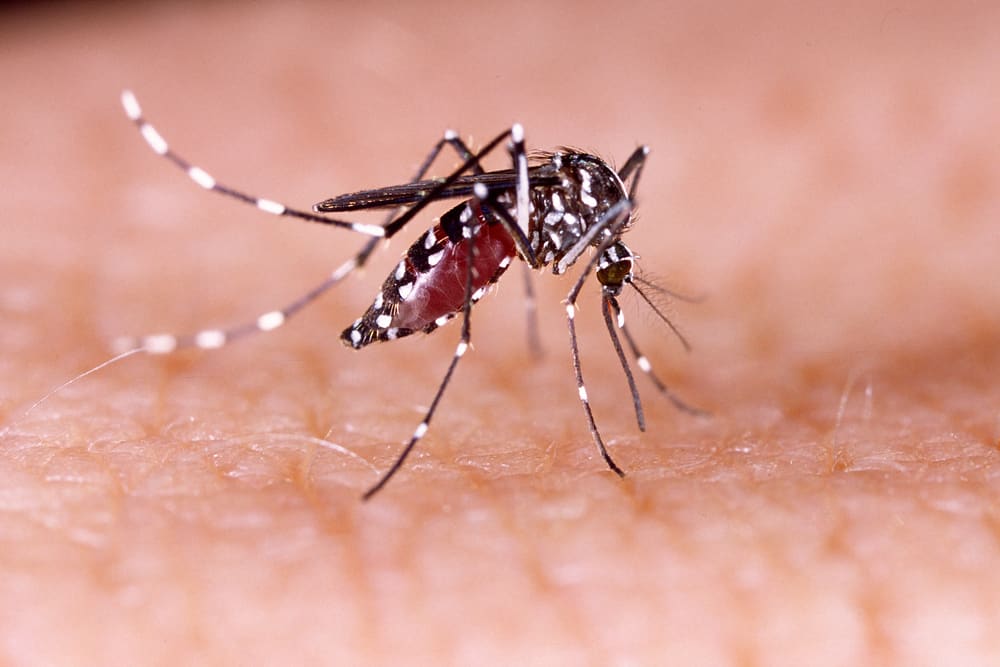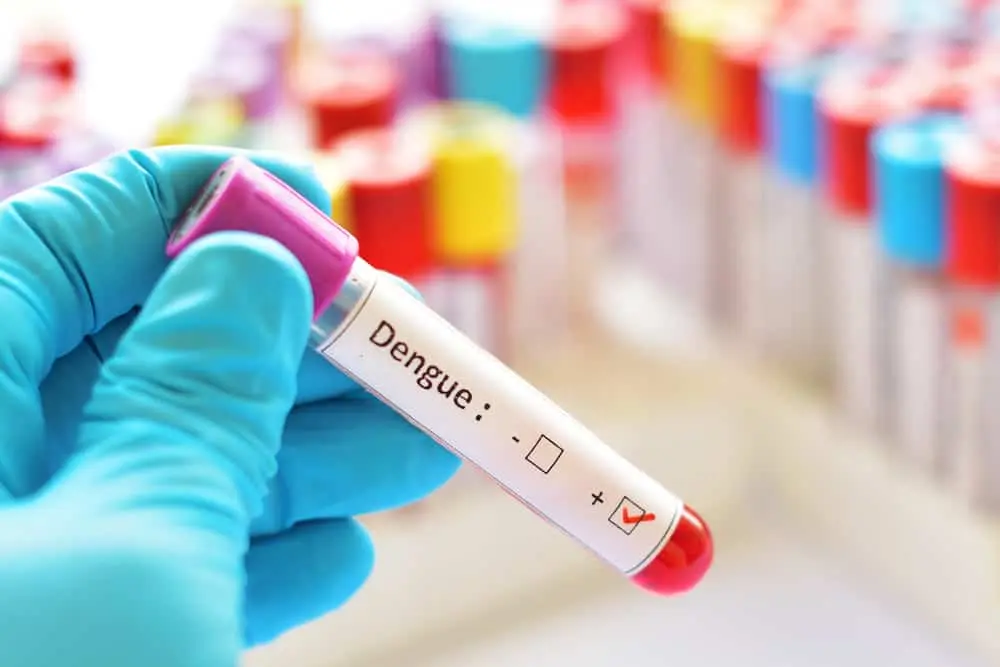Share This Article
Dengue hemorrhagic fever (DHF) is still a scourge for most Indonesians. Concerns about contracting this mosquito-borne disease are heightened during the rainy season.
The trend of DHF in Indonesia has continued in recent decades. Early detection and late treatment result in an increase in cases that end in death.
So, what are the symptoms and preventive measures that can be taken to avoid dengue hemorrhagic fever?
What is dengue hemorrhagic fever?
Dengue hemorrhagic fever (DHF) is a serious febrile illness transmitted by the female mosquito Aedes aegypti.
Dengue fever attacks the human circulatory system. Therefore, the disease can become more serious if one does not receive proper treatment immediately. Late treatment will only increase the risk of adverse effects and even death.
What causes dengue hemorrhagic fever?

Dengue fever can affect a person who has been bitten by a female Aedes aegypti mosquito. The mosquito carries a trigger virus from the Flaviviridae family, with four types of virus known as serotypes (DENV-1, DENV-2, DENV-3, and DENV-4).
The serotype can enter the human body through mosquito bites. The virus then takes over the mechanism of one’s body cells. Dengue hemorrhagic fever serotypes work by forming new protein components to reproduce themselves.
After that, new components of the virus that have increased in number will be released into the blood circulation system, and spread to all parts of the body. This is the beginning of the various symptoms that people with dengue hemorrhagic fever will feel.
Characteristics of dengue fever mosquitoes
Mosquitoes can be distinguished from other mosquito species by their distinctive black body color. The uniqueness of this mosquito is the light and dark pattern on its abdomen and chest, as well as on the legs.
Another characteristic of the dengue mosquito is its habit of laying eggs. They usually put their eggs in containers of water around the house. Including in unused places such as used bottles, tires and other garbage that can hold water.
In addition, the characteristics of dengue mosquitoes that you should not underestimate are their long life span as they usually rest in dark places (from cupboards, under beds to behind curtains) so that they are far from predators.
Who is more at risk of dengue hemorrhagic fever?
There are two factors that put you at great risk of contracting the DENV virus, namely:
- Travel to dengue-prone areas. Central Asia and Southeast Asia are two tropical regions where Aedes aegypti thrives.
- Previous dengue infection. A person who has not been declared fully cured but decides to stop taking medical drugs is at great risk of re-infection.
What are the symptoms and characteristics of dengue hemorrhagic fever?
The DENV virus carried by female mosquitoes has an incubation period of a week. This is the period when one feels symptoms that make the body uncomfortable.
According to the Ministry of Health, the most common symptom of DHF is a high fever throughout the day.
Unlike a normal fever , a rising body temperature will be accompanied by some pain in some parts of the body, especially the head and back.
In some cases, there are a number of signs that come in the form of heartburn. In addition, common symptoms that can be felt by a person with dengue hemorrhagic fever (DHF) are:
- Nausea and vomiting
- Muscle, joint and bone pain
- Pain at the back of the eye
- Swollen glands
- DHF causes red spots or rashes on the skin
Dengue rashes and spots are bright red and usually appear first on the lower limbs and chest. These dengue spots usually appear on the third day you are infected and last for 2 to 3 days afterward.
Phases of dengue fever
Quoting the Centers for Disease Control and Prevention (CDC), there are three phases that people with dengue fever will go through. They are feverish, critical and cured.
The febrile phase occurs for 2-7 days, while the critical phase of dengue lasts for 24-48 hours afterward. If the critical phase has been passed, then you will enter the recovery phase.
What are the possible complications of dengue hemorrhagic fever?
Dengue fever is a gateway to several other diseases if not treated properly. Two of the most common are lymph node and blood vessel damage.
This bleeding can lead to dengue shock syndrome (DSS), which has symptoms of dilated pupils, rapidly dropping blood pressure, weakened pulse, irregular breathing, and excessive cold sweat.
The risk of death in DSS is greater than dengue, due to organ failure.
Also Read: Don’t Underestimate Dengue Fever, Let’s Know the Symptoms!
How to manage and treat dengue hemorrhagic fever?
Dengue hemorrhagic fever treatment itself can be divided into two, namely through medical treatment and independently.
1. Treatment by a doctor
The symptoms of DHF mentioned above are similar to those of malaria and typhoid. The first step your doctor will take is to ask you about your symptoms, then perform a physical examination, such as a blood test to determine your platelet levels during dengue.
Platelets are blood cells that function for the clotting process. Platelet counts can indicate health problems in humans, including dengue. DHF patients have a platelet count below the normal threshold of 150,000 per microliter.
Hospitalization is the next stage you will get. During this time, the doctor will treat the symptoms. One of them is to increase the platelet count during dengue in the body to normal limits.
2. How to treat dengue at home
Self-treatment is usually done before going to the doctor to find out what is going on in the body. In this case, you can do several things to alleviate the symptoms, such as:
- Rest with a larger portion than usual.
- Using paracetamol as a pain and fever reliever. You should not use aspirin or ibuprofen, as they can cause bleeding.
- Drink plenty of water. Fluid intake is needed by the body to restore organ functions to normal.
If it doesn’t get better within five days, it’s a sign that your symptoms aren’t a normal fever. See a doctor immediately for proper diagnosis and treatment.
What are the commonly used dengue hemorrhagic fever medications?
Treatment for patients or sufferers is only supportive and symptomatic. This means that treatment is focused on the symptoms.
For example, when a person is being treated at a hospital for dengue, the medical staff will give them drugs that can boost their immunity.
That way, the virus will be easier to overcome until the patient’s condition gradually recovers.
Natural dengue remedies
Although there is no medical drug specifically used to cure dengue. However, there are some natural ingredients that are often used for dengue medicine.
Launching NDTV, here are some natural ingredients that are often used to treat dengue hemorrhagic fever (DHF):
- Papaya leaf juice. This juice is a good remedy for increasing platelet count. Moreover, it boosts immunity and also helps in treating dengue hemorrhagic fever.
- Fresh guava juice. Guava is often referred to as the fruit of dengue fever. This drink has many nutrients including a high vitamin C content that helps build immunity.
- Fenugreek seeds. Fenugreek boiled water is high in vitamin C, K, and fiber, which can reduce fever and boost immunity.
- Giloy juice. One of the well-known remedies for dengue hemorrhagic fever. Giloy juice boosts metabolism and builds immunity.
Using angkak for dengue
A study conducted at the University of Lampung examined the use of angkak for dengue. In their journal, researchers said that angkak can increase the specific immune system and platelet count.
The study said that angkak is a traditional medicine that contains isoflavones and lovastatin which act as anti-inflammatory compounds and increase platelets.
What are the foods and restrictions for DHF patients?
Here are the foods that people with DHF should avoid:
- Oily/fried food
- Spicy food
- Caffeinated drinks
- Soft drinks
- High-fat foods
- Avoid non-vegetarian foods
Here are foods and fruits that are good for people with dengue fever:
- Papaya leaf
- Pomegranate
- Coconut water
- Turmeric
- Fenugreek (Methi)
- Oranges
- Broccoli
- Spinach
- Kiwi fruit
Also Read: Dengvaxia DHF Vaccine: Instructions for Use and Side Effects
How to prevent dengue?
Both the WHO and the Indonesian Ministry of Health have explained that there is no effective treatment for the DHF healing process.
For this reason, it is necessary to prevent you from contracting the DENV virus from mosquitoes from the Aedes genus.
The Indonesian Ministry of Health has intensified the 3M Plus campaign as a prevention measure for dengue hemorrhagic fever, namely:
- Draining: cleaning water storage areas or containers, such as buckets, bathtubs, and drinking water containers.
- Closing: not leaving open places where water is stored, such as jugs, water tanks, and drums.
- Reusing: reusing items that are potential breeding grounds for mosquitoes.
The ‘Plus’ in the 3M Plus movement is:
- Sprinkle larvicide powder in water reservoirs that are not easy to clean.
- Use mosquito repellent to prevent bites or transmission from Aedes aegypti.
- Using mosquito nets in the room or bed.
- Plant mosquito repellent plants such as lavender and geranium.
- Keep fish that can prey on mosquito larvae.
- Change the habit of hanging clothes inside the house that can be a breeding ground for mosquitoes.
- Regulate ventilation and light in the house.
DHF Fogging
One way to prevent dengue fever that is often practiced in the community is dengue fogging. The goal is to reduce the mosquito population by spraying insecticides.
Based on research published in Enfermería Clínica, it is said that this dengue fogging method is more effective than the use of mosquito wires.
You don’t have to worry about the safety of this method. Because WHO itself has guaranteed that the smoke produced is not harmful to humans.
About dengue fever in children
Symptoms of dengue hemorrhagic fever are generally mild in younger children and those who have had the disease for the first time.
Older children, adults and those who have had a previous dengue infection may have moderate to severe symptoms.
Pain relief with acetaminophen can relieve headaches and pain associated with DHF in children. Pain relief with aspirin or ibuprofen should be avoided, as they can make bleeding more likely.
Dengue fever and malaria
Both dengue fever and malaria are transmitted by mosquito bites. Both also have similar symptoms.
The following dengue symptoms are similar to those of malaria:
- Headache
- General weaknesses
- Intense muscle pain
- Lower back pain
- Sick like you have the flu
- Chills
- Nausea
- Vomiting
- Cough
- Diarrhea
Similarities between typhoid and dengue symptoms
Typhoid and dengue hemorrhagic fever have similar clinical and epidemiologic features, and are difficult to distinguish in the early days of the disease.
Typhoid symptoms are usually characterized by indigestion such as diarrhea or constipation, then abdominal pain, and discomfort in the abdominal area.
While dengue hemorrhagic fever is usually also accompanied by bleeding symptoms. If you find symptoms of typhoid and dengue like the points above, contact your doctor immediately.
When to contact medical personnel?
Generally, a person will realize if they are experiencing dengue symptoms within 4-5 days after the first fever. Closer to a week, you should seek immediate medical attention to avoid other consequences.
The condition will worsen when platelet cell levels in the body drop dramatically. This will lead to some severe symptoms, such as:
- Body feels weak
- Difficulty breathing
- Nosebleeds or nose bleeding
- Cold sweat
- Severe abdominal pain
- Blood in urine or feces
- A rash on the skin that becomes more pronounced
If these severe symptoms have been felt, there is no need to hesitate to contact a doctor or health professional. Late treatment will only increase the chances of worse risks.
Transmission of dengue hemorrhagic fever
Indeed, the medium of dengue transmission is the female Aedes aegypti mosquito. However, the trigger virus does not only come from mosquitoes.
According to the World Health Organization (WHO), a virus that is already in a person’s body can also infect other mosquitoes that bite human skin.
1. Mosquito to human transmission
The most common transmission is from dengue mosquitoes to humans. The female mosquito will infect a person using the DENV virus, which eventually builds new components in the body and spreads through the bloodstream.
2. Human to mosquito transmission
Mosquitoes can also be infected with the DENV virus from humans. The way it works is that mosquitoes suck the blood of someone who has been exposed to the virus, whether they are in the treatment stage or have not yet developed symptoms.
DHF disease trends in Indonesia
The Indonesian Ministry of Health explained that dengue hemorrhagic fever cases in Indonesia often explode during the rainy and transitional seasons. The cycle starts from January to April every year. During this period, dengue cases will increase from other months.
DHF cases also commonly occur in low-lying areas. This is because cold temperatures make it difficult for female Aedes aegypti mosquitoes to breed.
In 2020, amid the COVID-19 outbreak, dengue hemorrhagic fever is still the disease with the most cases, reaching more than 17 thousand patients as of March. The three regions with the highest number of cases are East Java, East Nusa Tenggara and Lampung.
That is a complete review of dengue hemorrhagic fever, aka DHF. Let’s change our lifestyle and eradicate the habitat of the Aedes aegypti mosquito to avoid dengue!
Consult your and your family’s health problems through Good Doctor in 24/7 service. Our physician partners are ready to provide solutions. Let’s download the Good Doctor app
app here
!


